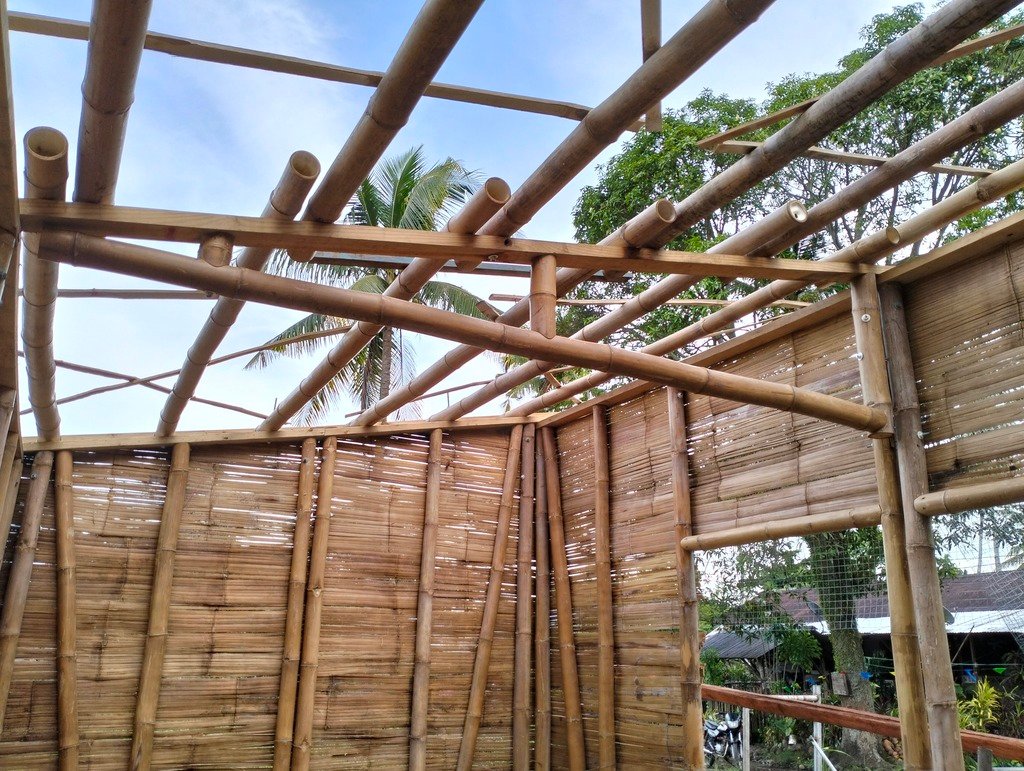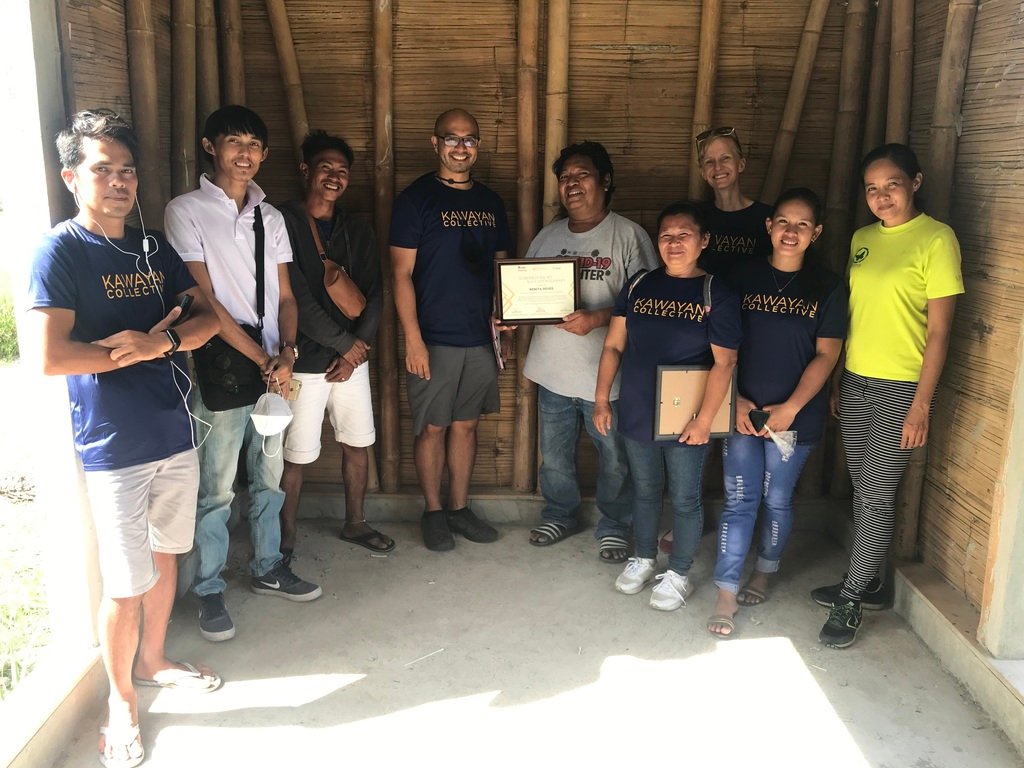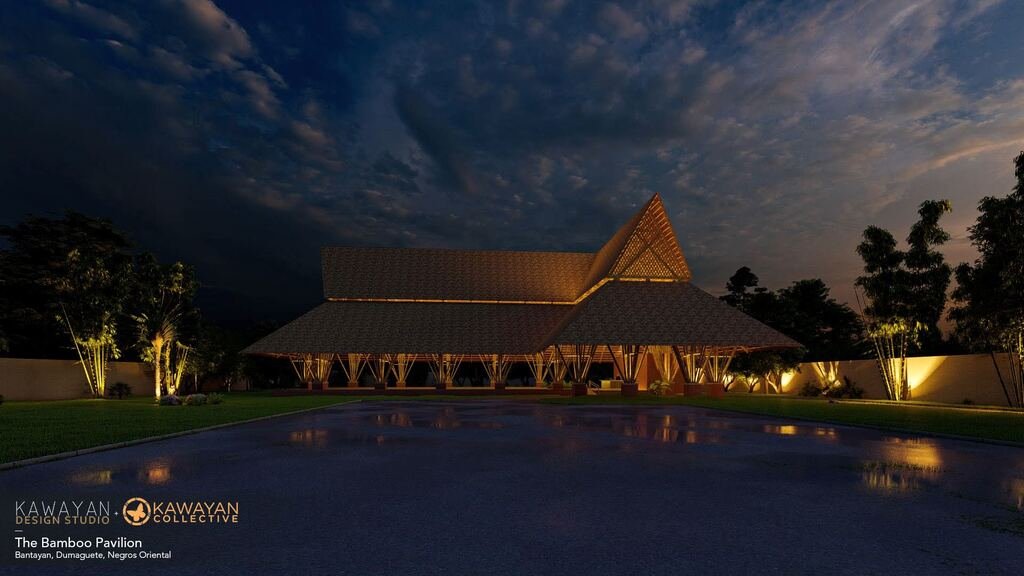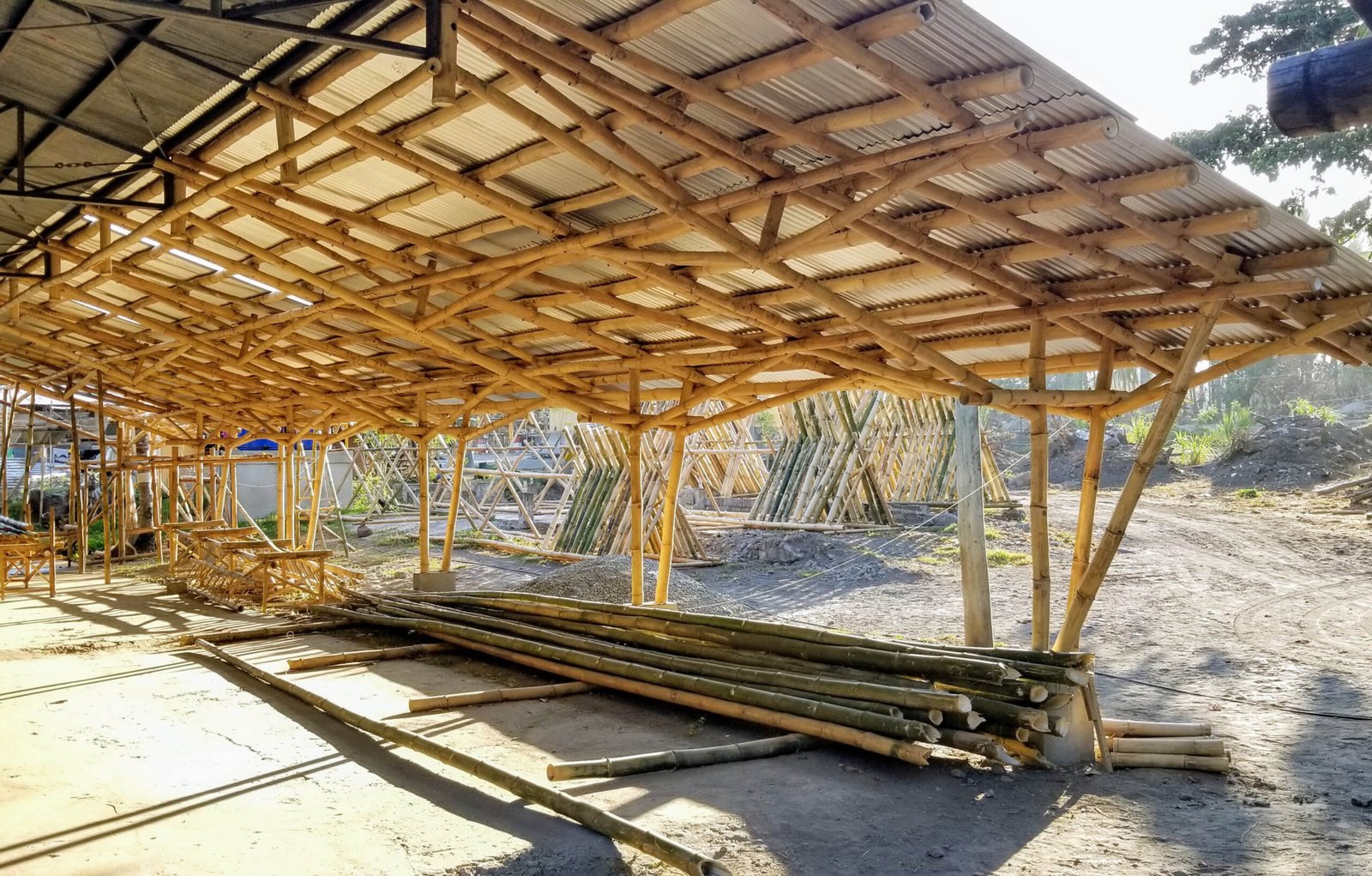Words Gabrielle de la Cruz
Interview Gabrielle de la Cruz and Judith Torres
Images Kawayan Collective


“You ask the ultimate question: How is Kawayan Collective different from all the other great work in bamboo in the world? We believe our differentiation is our focus on the full value chain and positioning as a social enterprise. While design is a very important part of creating beautiful structures and changing the perceptions around bamboo, our mission is to elevate the material by making quality construction-grade bamboo affordable and accessible to all Filipinos – not only those who can afford it. I like to describe our business as a treated bamboo lumber yard — not the sexiest innovation, but one that must be as commonplace as any hardware store or hollow block maker in order for there to be lasting impact,” opens Filipino-American architect Ray Villanueva during a series of email exchanges between Kanto and friends from the industry. He and his wife Amy established the Negros-based organization Kawayan Collective with the goal of building bamboo homes that are “resilient, durable, affordable, and aspirational.” They have championed the material since 2011 and are exploring new means and collaborations to broaden the reach of their bamboo crusade; they aim to make more believers out of the uncertain by putting their beliefs and findings into practice, something they did when they built their “dream home”, which they proudly claim to be 85% bamboo.
What follows is our conversation with Ray and Amy, who walked us through their beginnings with bamboo, the construction techniques and innovations they have developed for the material, and why they have high hopes for it as the world inevitably pivots to more sustainable materials.


Hi Ray and Amy! I would love to hear more about your appreciation for bamboo as a material. Do you remember your first bamboo encounter? Or perhaps the moment you developed an interest in it?
Ray: I grew up in the States, as far away from bamboo as possible. It was in 2011 that Amy and I first moved to the Philippines. I was teaching at an architecture school in Dumaguete called Foundation University. We started a program there called Estudio Damgo, a design-build course where senior architecture students design a community structure for a beneficiary community around the school. The first semester comprises the design and planning stage, then the second semester covers the building stage. It’s basically a community design-and-build thesis. The program continues until today. We were there for the first two years and it is in its 11th year now. This program was where I first interacted with bamboo and how I actually fell in love with it. I saw how skilled locals are with using bamboo and how easy it is for them to learn about it because of how intertwined it is with Filipino culture.
Bamboo is a part of everyday Filipino life — people cook with it, eat it, and even use it to get fruit from the trees. Even if you grew up with it in your backyard or just remember seeing it in your grandparents’ house, something about it just stays with you. I believe I was able to connect with it on that level, culturally and architecturally.
Amy: Honestly, my appreciation for bamboo didn’t really manifest until we started Kawayan Collective. The truth is, I’m in love with this guy right here, so I basically just fell in love with what he loves.
When Estudio Damgo was finished and the contract with Foundation University was completed, Ray and I moved back to the States. Once we were there, we realized how much our priorities and interests have changed. We were more directed to a life where we get to spend more time together and enjoy ourselves as a young family because we also had our first child then.
I was in grad school at that time, taking up business. I told Ray that I want to start our own business and that’s when he brought up the idea to work with bamboo. I had my parameters and we started to dream about what would be next. Fortunately, we met BASE Bahay Foundation and they ended up being our launch partner. My love of bamboo grew every day since then. I’ve learned a ton about it and I’ve come to respect it so much more. Now, I’m sitting in my dream house, which is made of 85% bamboo.




It’s amazing how all that led to your bamboo crusade. Can you tell us more about the initial steps you took to kickstart Kawayan Collective?
Amy: It wasn’t an overnight inception. It was a long and slow five year-journey. I was basically in school, completing my graduate degree. Ray was running a workshop for the University of Washington, bringing students from the US over to Dumaguete to build with bamboo. In all of that, research and networking were our primary means. That’s how we eventually met the right people and came up with the idea for Kawayan Collective.
We then chose a butterfly for our logo because it is a symbol that means many things to us: transformation, propagation, and rebirth. It is also a reference to the butterfly effect —that one small change in behavior can ripple to make a big impact.
How many people did you have when you were starting?
Ray: It was just the two of us for the first three months then we hired two supply leads. They were in-charge of going out into the mountains and finding bamboo that meets our specifications. One of them has an environmental advocacy background so she’s been in charge of environment-related aspects ever since. After the supply leads, we hired a construction team of about 7 to 8 people.
Amy: Probably half of the first few members worked previously at Buglas, so they came with experience and local knowledge of where bamboo can be found. I love how the other half was like me, who didn’t come with preconceived notions. We were all just learning, absorbing, and trying new things. Our early adopters were people in the Philippines looking for sustainable alternatives and looking out for the local environment.
Are all your team members from your municipality as well? How many of them are skilled in building with bamboo?
Ray: Around 90% of our entire team is from our municipality. We started with only three bamboo-skilled workers, with most being masons and laborers. It’s a lot of on-the-job training for those who do not have experience working with bamboo, with everyone just helping each other out.


What was the first Kawayan Collective project?
Ray: I think the first Kawayan Collective project was our facility. It is located in Maayong Tubig, Dauin, Negros Oriental. It is actually the old location of our predecessors, Buglas Bamboo Institute. They were in operation for 25 years and have been closed for 10 years now. We consider ourselves lucky because as we took over their space, we got to take advantage of the knowledge of the people who used to work there. We hired them for Kawayan Collective and we all collaborated to build our treatment facility and expand it.
We had to expand the covered area and put in new extensions so that it would be more of an industrial space. As designers, we love industrial spaces and we believe that we should showcase how bamboo can be used in settings like this. It’s important for us to show that bamboo is not just for the traditional bahay kubo or for resorts; it can be used for public buildings or anything that any other material can be used for.
We learned a lot from BASE Bahay, how the strongest connections can be made, and the typical rules of thumb when working with bamboo. We’ve been slowly adding to our factory and our team has also grown since then.



Bamboo house panels awaiting assembly
How has your process changed over time? Were there any changes that the pandemic introduced?
Amy: Honestly, our process now is still pretty close to how everything was before. When we started, we were 100% supplying BASE Bahay treated poles. The main focus was just getting the treatment process down for whole poles that met their construction grade criteria.
The pandemic hit just around our first anniversary, so everything had to stop. However, we had piles of offcuts in our facility from all of the materials that couldn’t go into the construction grade pool. The stack was so tall that we almost couldn’t see the road anymore, so we figured it was about time we dealt with it. Eventually, we started making beds for COVID facilities. We figured that this is where most of the community was at the time and we wanted to make our contribution. We got to put up around 90 beds in total.
That was also the time when we actually started to invest in shop equipment. We got basic machines, table saws, cleaners, and drum sanders to take these offcuts and turn them into engineered bamboo panels. I believe that this time helped us with our major hurdle. From the start, we knew that we needed to have a diversified market for our products and that we should think of more long-term solutions. It was great to find out that there was support in Negros and that home and business owners in our immediate community saw the value in what we were doing. People eventually started ordering and we slowly developed relationships with the local professional community of architects and engineers to encourage them to use bamboo in their projects as well.




Where do you source your bamboo? What kinds, qualities, or specifications do you look out for when sourcing them?
Ray: For the past few years, we’ve been working with a couple of researchers on the grading of our material to meet specifications. The most abundant here in Negros are kawayan tinik (bambisa bluemeana), so they’ve become our main species of interest. We do have botong (dendracalamus asper), but they’re not as plentiful.
We usually source 90% from our municipality. Out of our facility alone, we could do 100 to 200 bamboo homes every year.
Specifications involve everything — from diameter to wall thickness, to the node to node spacing, and to the straightness, curvature, and taper.
There are about 40 cutting teams in the mountains who help us supply regularly. They have visited our facility to learn all about our specifications and we conduct quarterly cutters meetings to know more about what they are finding. Our supply lead is the one in charge of going out and making sure that we’re only cutting the poles that we’re going to use. This aspect is very crucial because if you cut a pole that is too young, it’s not as strong. It is also not good for clump management and would not keep producing bamboo every year.



Kawayan Collective revealed that the Philippines adopted new bamboo international standards two years ago. “The PNS ISO 19624:2020 specifies the grading procedures required to achieve the degree of reliability intended for the structural application of bamboo culms while PNS ISO 22157:2020 specifies the test procedures for specimens obtained from round bamboo culms.” These include testing how strong bamboos are depending on where they’re grown, considering locations such as the mountains or by the sea, along with elevations and more.
The Department of Trade and Industry adopts ISO standards, but Ray says that what they present is usually just the framework. “This is where people from the building, construction, and design industry should come in and tailor everything with respect to the Philippine context.”
You describe Kawayan Collective as “a treated bamboo lumber yard.” Can you tell us more about your bamboo treatment techniques? What innovations or changes did you implement on pre-existing treatment regimes?
Amy: We use a tried-and-true treatment methodology that is documented and promoted by INBAR, as well as the permethrin soak solution mandated by BASE Bahay. We have found both treatment processes to be highly effective and nice complements to each other – offering our production team more flexibility and our customers cost-saving options.
There are lots of other treatment methods. We have a test wall on-site for every method we’ve heard of – saltwater soak, seasonal harvest, and painted-on solignum are some of the most popular. We do note that unfortunately, none but the saltwater soak has proven effective.
Ray: We are always testing and looking at all the possibilities. The office that we inherited is actually infested with termites. That’s the only way, really, unless you go to an actual lab and they perform their way of testing the degradation of bamboo over time.
There are several specialized bamboo connections, but these are connections that any skilled laborer can do. We usually use a fully threaded rod and cut it to size, then use nut and washer for both sides. We then fill the inside with concrete or cement to solidify that connection. If you drill it nicely, it doesn’t split and it comes out clean.
We also really love the fishmouth joint, which is a joint where materials meet end to end and are fastened together by a fishplate or fishplates. However, we don’t usually use metal screws. We either use a threaded rod, bamboo nail, or bamboo peg screws.
It’s mainly all about breaking down a house into panels just like cross-laminated timber or other panelized systems, and then making it really efficient by putting it all together. That’s the kind of innovation that we’re pushing for right now because it answers all questions about skilled labor and the quality of connections.
Connections are a big deal because that’s the main aspect where buildings fail during a typhoon, with the roof blowing off or any other thing happening. I guess, earthquakes with bamboo have always been okay, because buildings can sway. Typhoons are the big test because traditional houses blow away.



During the interview, Ray and Amy revealed to us that the house they are living in now went through its most difficult test thus far when Typhoon Odette made its landfall in the Philippines last December 2021. They recalled how it was a literal cacophony outside of their home, with trees falling and roofs flying off of houses. “It was one month into our new house and it was the biggest and scariest storm we’ve lived through, but there were no leaks and the house wasn’t even creaking. It was pretty rock solid.”


Bravo to you and your strong home! How long did it take you to build it? Do you still follow the same timeline whenever you put up bamboo houses?
Ray: The house where Amy and I live now is the very first house we’ve built. It took us about 7 months with 10 to 15 people in the workforce. That is honestly quite long and inefficient because we were still learning about all the processes.
In most houses that we’re recently building, we have completed the main structural frame for 3 to 4 months, which is quite faster than our process then. One of the main advantages of cement bamboo frames is being able to analyze and work simultaneously. When the concrete works are done, the bamboo panels just go ahead and fit onto the foundations. This is something we take pride in whenever we introduce building with bamboo to members of our community.
The Starter Home Kit is presented by Kawayan Collective as an attainable concept that maximizes the potential of bamboo as a material. With the idea of highlighting sustainable construction without being expensive, the collective’s goal is to demonstrate that everyone can live in a bamboo house. They aim to eliminate the notion that bamboo is only for those who can afford it as a luxury on one end, or as the last resort when there is nothing else left.



Training and workshops are conducted by Kawayan Collective at least once a month. This is one of their ways to address the myths, misconceptions, and assumptions about building with bamboo. Ray and Amy state that this is usually a full day on their production site, where participants are able to see and appreciate both the final product as well as the treatment and production process that goes into each kit. They provide people with tours of the facility and allow them to interact with the entire team and ask their questions. Each of the sessions seeks to showcase bamboo’s quality and durability as a material so that more and more people within their community and beyond will be convinced to use it across their endeavors.





Aside from bamboo homes, what other interesting projects and collaborations have you done so far?
Ray: We actually started a small subdivision behind our facility, we call it Kawayan Casitas. We’re going to build five model houses. We’re collaborating with other architects to keep it fresh and to reinterpret bamboo design a little bit more.
Amy: There’s also the Bamboo Pavillion.
Ray: In countries such as Bali, they usually have this huge, amazing public bamboo structure. That’s what we’re starting for the Philippines, we’re actually four months into construction for this new pavilion in Dumaguete. We’re working with local design firm Kawayan Design Studio to put up a 15-meter tall, 600-square meter pavilion.
Amy: As far as we know, it’s going to be the tallest bamboo structure in the Philippines.



Apart from the construction industry, where else do you see bamboo thriving as a material here in the Philippines? Do you see the same potential for our tropical neighbors here in Asia or in other parts of the globe?
Ray: Anything that preserves the craft of working with bamboo, furniture being a prominent example of course. The tropical regions around the world have the amazing opportunity to use this material that grows locally and abundantly. This is particularly interesting because we share similar climactic conditions with them and it proves how bamboo can be the answer to housing and reducing reliance on extractive processing or importing here in the Philippines.
As this material gains traction around the world in the high-end market, we moved here to make sure that the Philippines is a leader in the movement. And not only in exports but in positive impact – preserving traditions and activating a value chain that benefits so many Filipinos.
I’ve been a bamboo nerd ever since seeing photos of the first Vo Trong buildings 10 years ago and have always been in awe of Architect Bobby Mañosa’s work ever since I was a student trying to figure out what Filipino architecture is. Both have been huge inspirations for our Kawayan Collective journey so far and we dream of working with them and more architects and industry leaders in the future. I believe that a handful of South American countries have adopted bamboo in their building code already, like Colombia, Peru, and Ecuador. It all boils down to pushing the conversations and actions further now.


Individually and as founders of Kawayan Collective, what do you think makes bamboo beautiful?
Amy: I like its simplicity. The more we’ve gotten into manufacturing bamboo, the more I’ve appreciated what it already comes with, and what it’s naturally built to do. The poles here in our house don’t have any varnish on them, all they’ve done is grow in their clumps. When they’re the appropriate age, we just cut them so that their babies are already growing. We simply put them through a three-week treatment process and they’re good to go, they’re set.
Bamboo gave us this house. We didn’t do anything to the material except slice it. I think it’s just a stunning material. You don’t have to do much except treat it well, design it well, and protect it.
Ray: That was very well said. I think bamboo, in its round form, is just really beautiful. I guess I‘d compare the process to a farm-to-table experience. You get bamboo from the mountains, bring it down, and you build the house rather than having to process and create something that’s manufactured or material. That’s one of the most important points that we’re advocating for. Even though we sell engineered bamboo, our main advocacy is bamboo, in its entirety.
Engineered bamboo is really more of a high-end, upscale market that we’re trying to hit so that we can survive as a business. But the essence all lies in the potential we see in bamboo and in using it to preserve a lot of local traditions in building. As a Filipino-American and architect, the material has helped me a lot in trying to figure out what it means to be Filipino.
That first experience with Estudio Damgo that I talked about was that initial connection to the culture, but having Kawayan Collective and seeing the projects that are being done with it, it’s really satisfying to see how bamboo touches so many people along the way. The whole value chain is beautiful. It’s not just the material itself, but how it got there, how it is used, and how it betters people’s lives. I think that’s also a very important part of building with bamboo in the Philippines. It stimulates and activates so many livelihoods along the way.


When asked where they would want to see bamboo in the next five to twenty years, Ray and Amy described a future where there is mainstream adoption of treated bamboo. “I always talk about wanting to see every town in the Philippines having 3,000 clumps of bamboo within 10 kilometers someday. A time when bamboo treatment mills are as conventional as rice and corn mills. The day we get there is when bamboo is being maximized to its full potential. In five years, I hope that there would be more Kawayan Collectives. In ten years, I hope that it’s just ubiquitous,” Amy shares.
Ray calls on his fellow Filipino architects and people in allied industries to utilize bamboo. “It all boils down to choosing bamboo for a certain aspect in a design such as roof trusses or a building component. Maybe instead of deciding between a bamboo house and a concrete house, it could be a bamboo roof or floor as part of this concrete house. I look forward to the day when bamboo is part of the palate and there’s no need for either-ors.” •


Gabrielle de la Cruz started writing about architecture and design in 2019. She previously wrote for BluPrint magazine and was trained under the leadership of then editor-in-chief Judith Torres and previous creative director Patrick Kasingsing. Read more of her work here and follow her on Instagram @gabbie.delacruz.




One Response